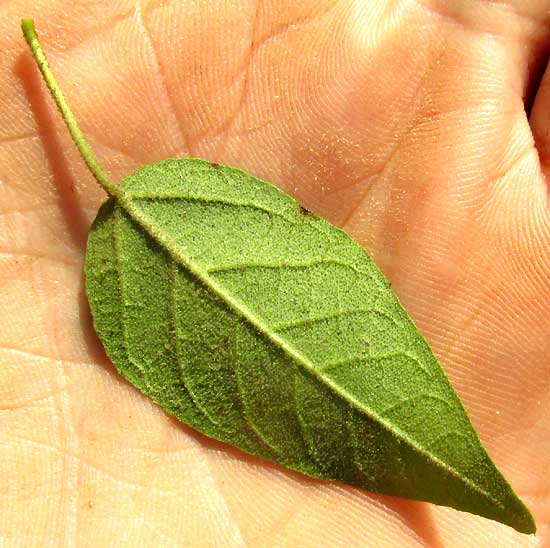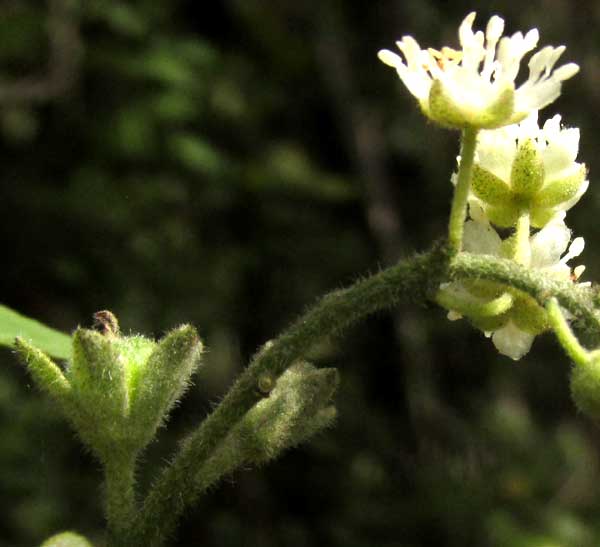Excerpts from Jim Conrad's
Naturalist Newsletter
from the January 25, 2019 Newsletter issued from Rancho Regensis north of Valladolid, Yucatán, MÉXICO;
elevation ~40m (~130 ft), N~20.876°, W~88.170°
LOW CROTON FLOWERING
Last week when I introduced the shrubby Ek Balam Croton, I mentioned that thirty-four species of the genus Croton, in the Spurge/Euphorbia Family, are listed for the Yucatan Peninsula, and probably at least a dozen might occur in our area. With so many look-alike species, identifying crotons can be hard.
In fact, this week when I was looking for more croton species, I realized that I'd been overlooking a commonly occurring one, one that often grew with -- even tangling branches with -- the Ek Balam species so abundantly growing along cow trails through the woods. Below, you can see a flowering branch of this second species, looking a good bit like the Ek Balam species:

This second species doesn't grow as tall as the Ek Balam, isn't as strongly woody at its base, the leaves' secondary veins are less crowded, the leaves' petioles grow longer, and the the whole plant is a little less hairy than the Ek Balam species. The relatively long petiole and less hairy undersurface of a typical leaf is shown below:

Another interesting difference is that in the Ek Balam species I don't see male and female flowers on the same plants, and even with this second species most individual plants bear unisexual flowers of just one sex. However, this second species sometimes produces female flowers below the raceme of male flowers, as shown below:

In that picture the female flower is at the bottom, left, while male flowers appear at the top, right. Below, a close-up of a female flower with its ovary expanding after pollination, and its stigmas turning brown and shriveling up, is seen:

A male flower bearing 26 or so stamens is shown below:

Last week we saw that sap of the Ek Balam species was orangish. This species' sap is almost clear, maybe with a slights tinge of orange, as shown below:

All these features lead to CROTON HUMILIS, a good old Linnaeus name, so it's been known for a long time, in contrast to the late-discovered Ek Balam species, which is endemic to the Yucatan. Croton humilis occurs mainly in the Caribbean area, but also the Yucatan Peninsula and Mexico's Gulf coast as far north as Texas and Florida. As such it's known by several English names, including Low Croton, Pepperbush, and Salvia. The latter two names are applied to other plants, but "Low Croton" is a translation from the binomial, humilis meaning low-growing or dwarf, so we'll call it that.
It's interesting to see how these two similar, apparently very closely related species flower and fruit at the same time in the same places, often their branches intermingling. A principle in ecology is that two different species can't occupy the exact same exact niche for long, before one out-competes and extirpates the other. The thing to note about these two species is that Croton humilis averages about half the height of the Ek Balam species. Along the cow trail, pollinators visit croton flowers at chest height on the Ek Balam species, at knee-to-waist height on Croton humilis.
Paul Standley, the great botanical explorer of the Yucatan, Belize and Guatemala during the 1930s, reported that Croton humilis was used medicinally as a stimulant, a diaphoretic (inducing sweating), an expectorant (promotes mucus formation in air passages so it can be coughed out and clear the passages), and to treat malaria.
The online Flora of North America observes that in Texas the male flowers of Croton humilis bear 30-35 stamens, but in Florida only 15-20. Therefore, our Yucatan plants fall between those two extremes, our sample flower with 26 or so stamens.